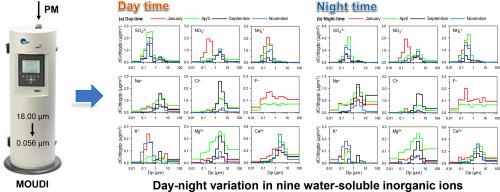当前位置:
X-MOL 学术
›
Atmos. Res.
›
论文详情
Our official English website, www.x-mol.net, welcomes your feedback! (Note: you will need to create a separate account there.)
Day–night variation and size distribution of water-soluble inorganic ions in particulate matter in Ulsan, South Korea
Atmospheric Research ( IF 5.5 ) Pub Date : 2021-01-01 , DOI: 10.1016/j.atmosres.2020.105145 Tien Van Do , Quang Tran Vuong , Sung-Deuk Choi
Atmospheric Research ( IF 5.5 ) Pub Date : 2021-01-01 , DOI: 10.1016/j.atmosres.2020.105145 Tien Van Do , Quang Tran Vuong , Sung-Deuk Choi

|
Abstract In the present study, 11 size classes of particulate matter were collected from a semi-rural site in the industrial city of Ulsan, South Korea in 2019 to investigate the size distribution and day–night variation of water-soluble inorganic ions (WSIIs). Approximately 70% of the detected WSIIs were found in fine particles, with Na+, Ca2+, Cl−, and NO3− dominant (~70%) in coarse particles and SO42−, NO3−, and NH4+ (SNA) dominant (~70%) in fine particles. Monthly variation in total WSIIs was observed, with the highest average concentration found in April for both coarse (2.71 μg/m3) and fine particles (5.75 μg/m3). Given that this month is characterized by prevailing southeasterly winds, these high levels may represent the adverse effects of industrial activity. Coefficients of divergence for individual WSIIs exhibited large variability, which is indicative of significant day–night differences in meteorology, chemistry, and source contributions. The size distributions of Na+, K+, F−, Cl−, NO3−, and SO42− were bimodal, while Mg2+, Ca2+, and NH4+ were unimodal. Peaks were generally found at 1.8–5.6 μm and 0.18–0.56 μm for coarse and fine particles, respectively. By plotting the linear relationship between the mole charge ratios of SNA, we found that coarse NO3− particles were mainly the result of heterogeneous reactions between HNO3 and sea salts or crustal species, while the homogeneous reaction of HNO3 and NH3 played a crucial role in the formation of fine NO3− particles. In conclusion, though day–night variation in WSIIs was apparent, especially in SNA, the formation pathways for both coarse and fine particles were similar for day and night. Based on the verification of the formation mechanisms for WSIIs at this semi-rural site, the influence of industrial activity on the secondary formation of PM in urban and industrial areas can be investigated further.
中文翻译:

韩国蔚山颗粒物中水溶性无机离子的昼夜变化及粒径分布
摘要 本研究于 2019 年在韩国蔚山工业城市的一个半农村地区收集了 11 个粒径等级的颗粒物,以研究水溶性无机离子 (WSII) 的粒径分布和昼夜变化。 . 大约 70% 的检测到的 WSII 存在于细颗粒中,粗颗粒中 Na+、Ca2+、Cl- 和 NO3- 占主导地位(~70%),而 SO42-、NO3- 和 NH4+(SNA)占主导地位(~70%) ) 细颗粒。观察到总 WSII 的月度变化,粗颗粒 (2.71 μg/m3) 和细颗粒 (5.75 μg/m3) 的平均浓度最高在 4 月。鉴于本月盛行东南风,这些高水平可能代表工业活动的不利影响。单个 WSII 的发散系数表现出很大的可变性,这表明气象、化学和来源贡献存在显着的昼夜差异。Na+、K+、F-、Cl-、NO3- 和 SO42- 的尺寸分布是双峰的,而 Mg2+、Ca2+ 和 NH4+ 是单峰的。通常分别在 1.8-5.6 μm 和 0.18-0.56 μm 处发现粗颗粒和细颗粒的峰。通过绘制 SNA 的摩尔电荷比之间的线性关系,我们发现粗 NO3− 颗粒主要是 HNO3 与海盐或地壳物种之间的非均相反应的结果,而 HNO3 和 NH3 的均相反应在其中起着至关重要的作用。形成细小的 NO3− 颗粒。总之,虽然 WSII 的昼夜变化很明显,尤其是在 SNA 中,但粗颗粒和细颗粒的形成路径在白天和晚上是相似的。
更新日期:2021-01-01
中文翻译:

韩国蔚山颗粒物中水溶性无机离子的昼夜变化及粒径分布
摘要 本研究于 2019 年在韩国蔚山工业城市的一个半农村地区收集了 11 个粒径等级的颗粒物,以研究水溶性无机离子 (WSII) 的粒径分布和昼夜变化。 . 大约 70% 的检测到的 WSII 存在于细颗粒中,粗颗粒中 Na+、Ca2+、Cl- 和 NO3- 占主导地位(~70%),而 SO42-、NO3- 和 NH4+(SNA)占主导地位(~70%) ) 细颗粒。观察到总 WSII 的月度变化,粗颗粒 (2.71 μg/m3) 和细颗粒 (5.75 μg/m3) 的平均浓度最高在 4 月。鉴于本月盛行东南风,这些高水平可能代表工业活动的不利影响。单个 WSII 的发散系数表现出很大的可变性,这表明气象、化学和来源贡献存在显着的昼夜差异。Na+、K+、F-、Cl-、NO3- 和 SO42- 的尺寸分布是双峰的,而 Mg2+、Ca2+ 和 NH4+ 是单峰的。通常分别在 1.8-5.6 μm 和 0.18-0.56 μm 处发现粗颗粒和细颗粒的峰。通过绘制 SNA 的摩尔电荷比之间的线性关系,我们发现粗 NO3− 颗粒主要是 HNO3 与海盐或地壳物种之间的非均相反应的结果,而 HNO3 和 NH3 的均相反应在其中起着至关重要的作用。形成细小的 NO3− 颗粒。总之,虽然 WSII 的昼夜变化很明显,尤其是在 SNA 中,但粗颗粒和细颗粒的形成路径在白天和晚上是相似的。


























 京公网安备 11010802027423号
京公网安备 11010802027423号